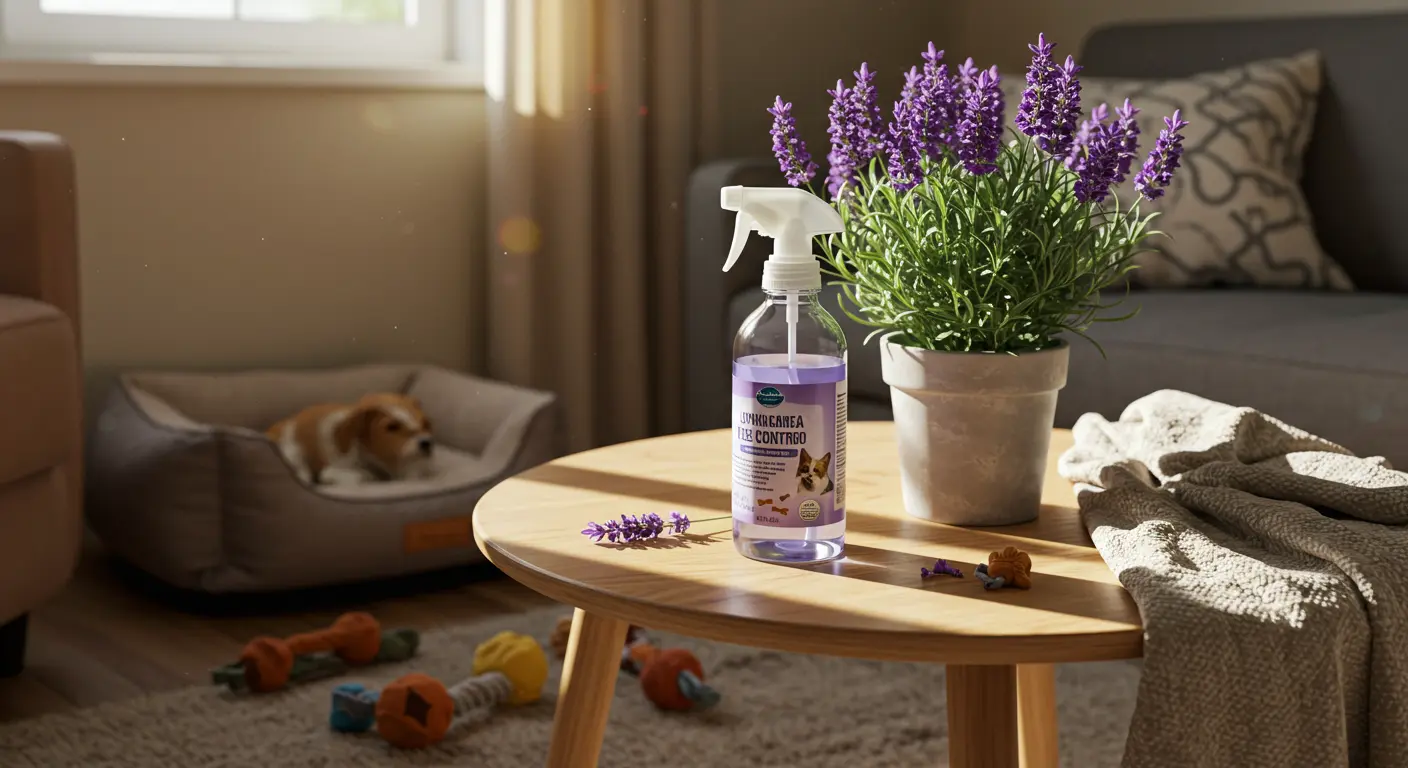Understanding Lavender Oil and Fleas
Lavender oil has emerged as a beloved natural approach to flea control, though you should understand its limitations. This aromatic essential oil functions as a repellent rather than an insecticide, creating an unwelcoming environment that discourages fleas from settling in treated areas and around pets.
Beyond pest management, lavender showcases remarkable versatility. Aromatherapy enthusiasts prize it for relaxation, while homeowners incorporate it into cleaning routines. In gardens, lavender plants act as natural sentinels, shielding neighboring flora from troublesome pests like whitefly.
How Does Lavender Oil Repel Fleas?
The secret behind lavender oil’s repellent power lies in its complex chemical makeup, specifically compounds like linalool and finally acetate. These aromatic molecules interfere with flea sensory receptors, disrupting the scent trails these parasites rely on to locate their next meal.
When strategically applied to surfaces or carefully diluted for pet-safe use, lavender oil creates a protective zone. Rather than relying on toxic compounds, lavender operates through pure aversion—fleas simply find the fragrance intolerable and seek refuge elsewhere. This makes lavender particularly valuable as a preventative measure in low to moderate risk environments.
Lavender offers an additional benefit: while repelling fleas, it attracts beneficial insects—bees, butterflies, and natural predators that maintain ecological harmony. In garden settings, lavender plants serve as natural guardians, protecting neighboring plants from destructive pests like whitefly and aphids. This dual action of repelling harmful insects while attracting helpful ones makes lavender a smart addition to both indoor and outdoor pest management strategies.
Effectiveness of Lavender Oil Against Fleas
The key point: lavender oil repels rather than kills. It won’t eliminate fleas or eradicate an existing infestation—a fundamental limitation that shapes any realistic flea control strategy.
Think of lavender oil as a bouncer at the door rather than an exterminator inside the house. Its repellent properties can moderately deter newcomer fleas from settling into treated areas, but it’s virtually powerless against established populations already thriving in your home or on your pets.
Think of lavender oil as a helpful addition rather than a primary solution. Active infestations demand proven insecticides—whether conventional or alternative natural treatments with genuine killing power.
Safety Considerations for Pets
Pet safety requires careful attention when using lavender oil. While this essential oil enjoys a reputation as a gentle, natural remedy, the reality is far more nuanced, with safety profiles varying dramatically between species.
Dogs present a different scenario entirely. When properly diluted, lavender oil can serve as a mild canine repellent, though this comes with non-negotiable safety requirements.
Always consult your veterinarian before introducing any essential oil to your pet’s routine. Remember: ‘natural’ and ‘safe’ aren’t synonymous.
Diluting Lavender Oil for Safe Use
Creating a dog-safe lavender solution requires precision: combine 1–2 drops of pure lavender essential oil with one tablespoon (15ml) of carrier oil. Quality carrier oils that minimize skin irritation include:
The mixing process demands attention to detail. Measure your chosen carrier oil into a dark glass bottle, add the precise amount of lavender oil, then seal and gently roll between your palms to ensure thorough blending.
Environmental treatment requires a different approach: blend 5–10 drops of lavender oil with 8 ounces of water and a dispersing agent like witch hazel in a spray bottle. Lightly mist this solution onto pet bedding, furniture, or carpets, ensuring complete drying before your pet returns to these areas.
Multi-pet households face additional challenges: lavender remains off-limits for cats regardless of other pets present. Choose methods that protect all your animals equally.
Integrating Lavender Oil with Other Flea Control Methods
Lavender oil works best as part of a comprehensive flea management strategy rather than shouldering the burden alone. It complements other flea control methods rather than replacing them.
Strategic environmental maintenance amplifies lavender’s repellent effects:
-
Vacuum relentlessly: Focus on carpets, rugs, and upholstery where flea eggs and larvae lurk.
-
Launder bedding weekly: Hot water treatments eliminate all life stages.
-
Deploy steam cleaning: High-temperature treatments penetrate deep into fabrics, destroying fleas at every developmental stage.
For moderate to severe infestations, veterinary-prescribed treatments remain your most powerful allies. Here, lavender oil assumes a supporting role—deterring new arrivals while conventional products handle the heavy lifting of elimination.
Establishing “flea-free sanctuaries” throughout your home adds another defensive layer. Use your lavender spray on pet bedding and resting areas while maintaining strict flea treatment protocols. Maintain a consistent schedule for all flea control activities.
Always consult your veterinarian to develop a safe and effective integrated flea control plan for your specific situation.
Professional Pest Control Options
When home remedies like lavender oil and conventional treatments fail against persistent or severe flea invasions, professional pest control may be necessary. These specialists wield commercial-grade products and specialized equipment capable of eliminating fleas at every life stage—something DIY approaches often can’t achieve.
Many professional services use Integrated Pest Management (IPM), which focuses on long-term prevention through multiple coordinated techniques instead of relying solely on chemicals. Companies like Bug Out specialize in eco-friendly pest management solutions that are both effective against fleas and safer for your family and pets than many DIY chemical alternatives.
Professional intervention delivers distinct advantages:
-
Complete Life Cycle Targeting: Professionals attack eggs, larvae, pupae, and adults simultaneously.
-
Guaranteed Follow-Through: Return visits ensure complete eradication rather than temporary relief.
-
Performance Guarantees: Many services back their work with satisfaction guarantees.
Choose your pest control partner carefully:
-
Check for pet-safe specialization and positive reviews from other pet owners.
-
Ask about their methods, including the products they use and any guarantees offered.
-
Request a detailed assessment and a clear treatment plan before work begins.
Professional services require higher upfront investment than DIY methods like lavender oil, but they frequently prove more economical long-term by resolving stubborn infestations swiftly and completely. For persistent flea problems that resist other treatments, professional intervention typically offers your most reliable route to a genuinely flea-free home.
FAQs About Lavender and Fleas
Here are answers to frequently asked questions about using lavender oil for fleas.
Does lavender oil actually kill fleas?
No. Lavender oil operates purely as a repellent, lacking any insecticidal properties. While it may discourage fleas from settling in treated areas, it cannot eliminate existing populations—especially in moderate to severe infestations where established colonies continue thriving.
Is lavender oil safe for all pets?
No. Safety varies dramatically by species. Dogs can tolerate properly diluted lavender oil as a mild repellent, but cats face serious toxicity risks. Felines lack essential liver enzymes needed to metabolize essential oils, making even small amounts of lavender potentially dangerous.
How often should I apply lavender treatments?
Lavender’s effectiveness fades quickly—typically requiring reapplication every 1–2 days as the scent dissipates. However, frequent applications increase skin sensitivity risks, so monitor your pet closely for any adverse reactions. Less is often more with essential oils.
Can lavender completely replace conventional flea treatments?
No. Lavender offers modest repellent benefits at best, while effective flea management demands a comprehensive strategy. This typically includes veterinary-approved medications, environmental treatments, and rigorous cleaning protocols working in concert.
What’s the best way to use lavender for flea prevention?
Environmental application proves safest and most practical. Consider placing dried lavender sachets near pet resting areas or using properly diluted sprays on furniture and carpets. Avoid direct application to cats entirely, and seek veterinary approval before using on dogs.
Why isn’t my lavender treatment working?
Lavender’s limitations likely explain your disappointment. As a mild repellent with inherently limited effectiveness, it simply cannot handle established infestations. Additionally, inconsistent application, improper dilution, or treating only portions of your environment further reduces its already modest efficacy. Serious flea problems require serious solutions.




